Hi Everyone again ! :D
In last blog i show you some history about nascency of tank and id show you first tank ever, id show you some legendary tanks from both World wars and now i will writing about what was happening after WW-s.
Cold War
Cold war was great time for tanks because many countries spend their money for their armies and tank was one of the essentials war machines on the battlefield. In Cold war there was created a lot of legendary tanks wich construction and technology we are also using today. They are called
Second generation tanks
Armament 1 - 125mm (2A46) D81TM smooth bore gun
1 - 7.62mm MG coaxial
1 - 12.7mm (NSV)AA MG
Engine: 10 cyl. opposed piston Model 5DTF multi-fuel diesel
750 hp, coupled to power-assisted transmission
Speed: 46 mph
Range: 310 miles
Crew: 3
Weight: 43 tons
Retains low silhouette of the T55/62. Has greater mobility than the T-62. Main gun is stabilized in 2 planes but does not have "on the move" firing capability of the Western MBTs. Gun can fire fin stabilized APFSDS, HE and HEAT ammunition as well as the Songster AT-8 missile and is equipped with an auto-loader. Hull is covered with steel/ceramic inserts called Combination K. Sides of hull are covered with gill type armor panels which spring outwards to reduce effectiveness of HEAT projectiles. A toothed shovel/dozer blade is attached to the front of the hull, and there are attachment points for a mine clearing plow. Snorkel, night vision, fire detection and suppression, and an NBC system are standard equipment.
This tank was not exported but was produced solely for the USSR. More than 8000 were produced. Improvements led to the T-80 model tank.
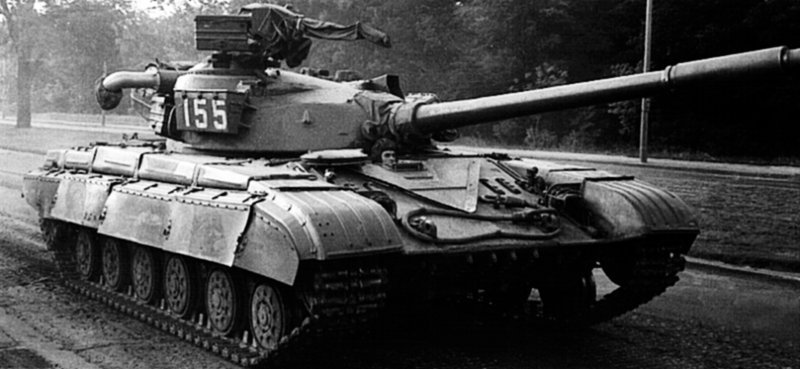
Armament: 1 - 125mm 2A46 smooth bore gun
1 - 7.62mm MG coaxial
1 - 12.7mm remote controlled DShK AA MG
Engine: Model V-46, V-12, diesel or multi-fuel, 840 hp
Speed: 50 mph
Range: 278 miles
Crew: 3
Weight: 48.9 tonsThe T72M was first seen in 1980. This version replaced the optical range
finder with a laser. The T72M also has improved armor on the front. The resulting thickened front led US Tankers to nickname it the "Dolly Parton" Tank. Auto-loading system for the main gun which is stabilized in two planes. It can fire 3 types of ammunition: APFDS, HEAT-FS and HEAT-FRAG. The gun can also fire a laser guided AT missile. IR searchlight mounted to right side of main armament. Dozer blade mounted on front hull and 2 - 200 liter fuel tanks externally at rear. Sloped glacis with deep V-splash board. Can be fitted with mine clearing equipment. Standard equipment includes NBC system, fire detection and suppression, snorkel for fording up to 5 meters, night vision equipment. Exported to former Warsaw Treaty members. An estimated 50,000 have been built.

Armament: 1 - 105mm gun
1 - 7.62 coaxial MG
1 - .50 cal MG in cupola
Engine; Continental,V-12 , AVDS-1790-2A , diesel
750 hp
Speed: 30 mph
Range: 295 miles
Crew: 4
Weight: 46 tons
The 105mm gun is a modified British weapon. Modified M48
hull, wedge shaped. Used turret from M48A2. Total
of 2,200 built. Superseded by M60A1. The diesel was a
great improvement over the gasoline engines in the M48.
Range was increased to almost 300 miles. When not in
combat, turret is traversed to rear to reduce length.
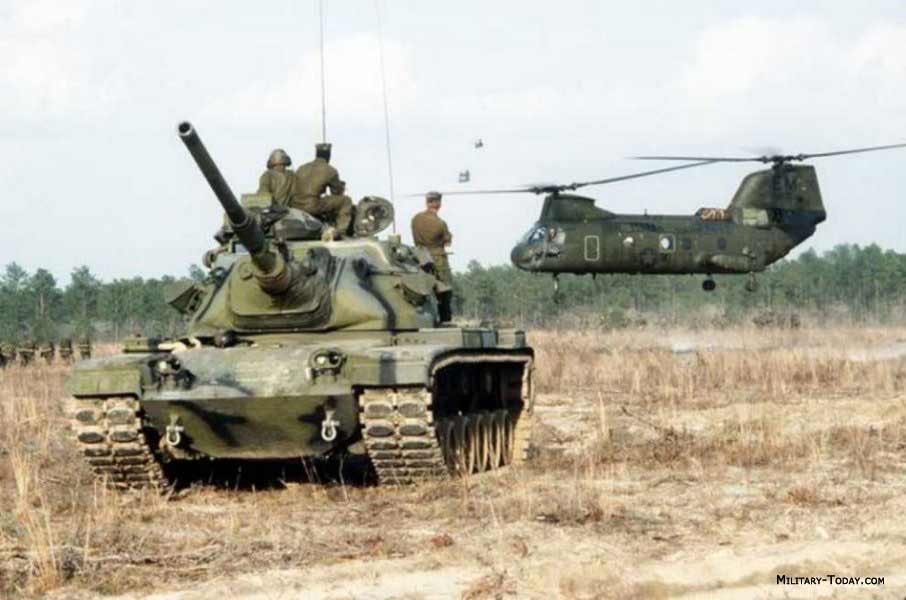
Armament: 1 - 105mm rifled gun L7
1 - 7.62mm coaxial MG
1 - 7.62mm MG
Powertrain: MTU MB 838 Ca M-500 10 cyl. multi-fuel, 830 hp,
coupled to ZF4 HP 250 automatic transmission
Speed: 40.3 mph
Range; 372 miles
Crew 4
Weight: 42 tonsFour variants were produced. Main gun can be fired on the move with
electronic hydraulic gyroscopic gun stabilizer. More than 6,000 exported to nine NATO countries. 2,237 were produced for the German Army. This is a minimum maintenance vehicle. Capable of deep fording with kit. Has computerized fire control system and day/night vision. Standard equipment includes fire detection and suppression and a full NBC system, One of the best European tank designs.
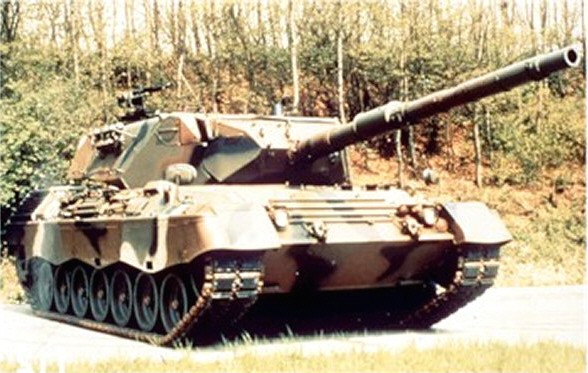
The AMX-30 main battle tank was developed in late 1950's to meet the French Army requirements. First prototypes were built in 1960 and it entered service with the French Army in 1963. Production of this MBT commenced in 1966 and ceased in 1993. Between 1974 and 1984 the AMX-30 was also license-produced in Spain. About 2 800 of these main battle tanks including variants were built for the French Army and export customers. It is now being replaced with the Leclerc MBT in the French Army. The AMX-30 is still in service with France, Bosnia, Cyprus, Qatar, Saudi Arabia, United Arab Emirates and Venezuela. The AMX-30 has a welded hull and cast turret. It's development was focused on firepower and mobility rather than protection. Vehicle is fitted with NBC protection and automatic fire suppression systems. Armor of the AMX-30 is very thin and protects only from small-bore cannons and artillery shell splinters. It can be penetrated by all modern anti-tank weapons. The AMX-30 is considered as the worst protected main battle tank ever built. The AMX-30 is fitted with non-stabilized French CN-105 F-1 105-mm rifled gun, which is comparable with the British L7, but has a longer 56 calibers barrel. The AMX-30 fires APFSDS, HE, HEAT, HE-FRAG, incendiary, smoke and illumination rounds. It is also compatible with all standard NATO 105-mm munitions. A total of 47 rounds are carried. Secondary armament consists of 20-mm cannon with independent elevation and a roof-mounted 7.62-mm machine gun. The first production AMX-30 main battle tanks were fitted with 12.7-mm machine guns in place of the 20-mm cannons. Vehicle has a crew of four, including commander, gunner, loader and driver. The AMX-30 is powered by Hispano-Suiza HS-110 multi-fuel diesel engine, developing 720 horsepower. It is fitted with a deep wading kit and can ford water obstacles up to 4 meters deep.

The Merkava, (Chariot) is the main battle tank of the Israel Defense Forces. Since the early 1980s, four main versions have been deployed. The "Merkava" name was derived from the IDF's development program name.It is optimized for crew survival and rapid repair of battle damage. Through the use of spaced-armor techniques and quick-replacement modular designs, the design team was able to incorporate composite armour, a derivative of rolled homogeneous armour (RHA) and Chobham armour. Additionally, the space between the inner and outer hulls is filled with diesel-an economical storage method and a means of defeating HEAT rounds.Following the model of contemporary self-propelled howitzers, the turret assembly is located nearer the rear than in most main battle tanks. This gives the crew additional protection against a frontal attack by putting the engine between them and the attack. This arrangement also creates more space in the rear of the tank that allows increased storage capacity, as well as a rear entrance to the main crew compartment allowing easy access even under enemy fire. This allows the tank to be used as a platform for medical disembarkation, a forward command and control station, and an armoured personnel carrier. The rear entrance's clamshell-style doors provide overhead protection when off- and on-loading cargo and personnel.It was reportedly decided shortly before the beginning of the 2006 Lebanon War that the Merkava line would be discontinued within four years. However, on 7 November 2006, Haaretz reported that an Israeli General Staff assessment had ruled of the Merkava Mark IV that "if properly deployed, the tank can provide its crew with better protection than in the past," and deferred the decision on discontinuing the line.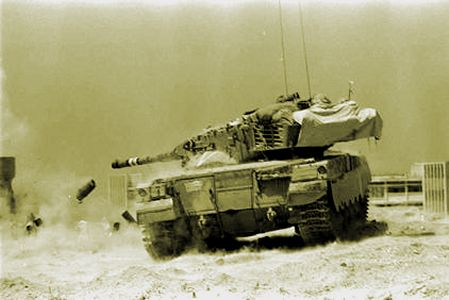
The Type 80 main battle tank was developed by NORINCO in the early 1980s. It is a radically improved version of the Type 69 MBT. Vehicle has a redesigned hull, which is longer comparing with the Type 69. Front of the hull and turret can be fitted with composite armor. The Type 80 features steel side skirts, common to all Chinese main battle tanks. Turret of the Type 80 is similar to that on the Type 79 MBT (export version of the Type 69). The Type 80 is armed with the L7/M68 105-mm rifled gun. It fires all standard NATO 105-mm ammunition, which is also manufactured in China under license. This gun is loaded manually. Fire control system of the Type 80 is similar to that of the Type 69-II MBT. Secondary armament consists of 7.62-mm coaxial machine gun and 12.7-mm anti-aircraft machine gun. Vehicle has a crew of four, including commander, gunner, loader and driver. The Type 80 main battle tank is powered by the 12150L-7BW diesel engine, developing 730 hp. Vehicle can be fitted with a deep wading kit. Variants Type 80-II is fitted with improved fire control and NBC protection systems; Type 85-II, developed in 1989, is a further development of the Type 80-II, featuring new turret and additional modular armor at the front of the hull and turret; Type 85-IIA command tank, fitted with additional communication and navigation
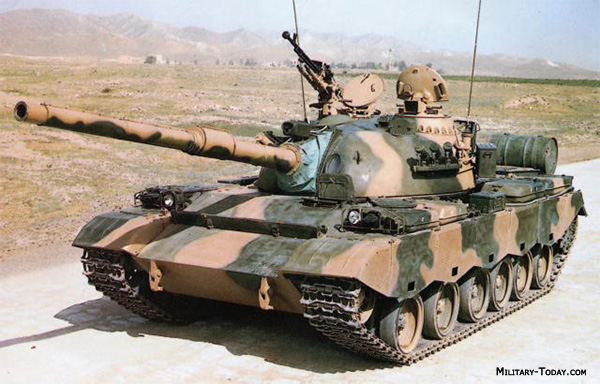
Thanks for watching, to be continued....

the type -80 looks kinda like the battlemaster. nice tank anyways.
The battle master from Generals is based on chinese Type 59-88 tanks
of all cold war tanks,the Merkava!
the merkava is not the best tank, just the look
hay thank you for interste information about cold war tanks
Soviet tanks owned them. NATO generals was scared because of them... and Merkava I failed in combat against Syrian T-72M... who was downgraded export model, not real stuff.
are you serious?
The Merkavas were more than successful against those cheap T-72s during the 1982 Lebanon War.
The Syrian 73rd Brigade used T-72s during the war,as soon as the Israelis opened fire the Syrian tanks were burning,the merkava had an incredible success rate in 1982,get your facts straight
the 1982 Lebanon war ****** up many people's lives ouch...
O really? And wherefrom is this information? During that war only nearly 9 T-72 were destroyed and NOT by Merkava. Why? They simply didn't meet on the battlefield. Most likely those tanks were destroyed by 409th AT brigade, mean chance that those tanks were destroyed by Cobras or Sho'ts from 514th armor tank division, and almost no chance that those tanks were destroyed by Merkava, because they reached that region after cessation of fire.
THIS is official report from History Department of Israel Defence Forces. Everything other - folklore. Fables from frontlines are not acceptable.
well if there was no real confrontation in the first place,then Mitkovich's point is wrong
and that makes mine wrong too then
Are you serious? First of all, I mention Soviet models, not export crap monkey models. I can spend all day explaining you differences between original versions and ones made for export, but I will do that in 1 sentence: Models for Soviet army had thicker armor, better FCS, better ammunition, nightvision, termovision equipment, also crew was far better trained.
Export ones(T-72M and T-72M1) had weaker armor(in most case RHA, not composite like Soviet ones), downgraded autoloader, bad FCS (T-72M and M1 use FCS from T-62), outdated ammo, lack of proper nightvision, no termovision sights... tanks looks almost same, but they are way too different. YOu must learn to make differences between Soviet ones and Export models.
I am aware of the fact that exported models of most Cold war era tanks where severely down graded,but still a T-72 is a T-72
16 year old "kid"?
relax man no need to point that out
I already explained difference between export downgraded T-72M and Soviet T-72A.
You cant compare tank with basic conventional steel armor, no proper nightvision equipment, bad balistic computer and FCS from T-62, with Soviet tank who had composite armor, superior FCS, Nightvision equipment, improved balistic computer and superior ammo. These are basic differences between T-72M and T-72A.
If you are interested about details, send me message... and don't try to look smart, because you don't know anything about potential of original T-72.
Comrade, do not forget that he is 16 year old kid and that I already served army on T-72B.. I sit on facts, not on data picked up on internet like him. ;-)
Facts about what?
the 1982 Syrian-Israeli conflict?
Facts that I spent 3 years inside T-72B and that I study about him for damn long time.
I bet that you didn't even saw him in real life.
Agree. Simply when we are comparing "tanks" - we should not forget that we are not talking only about "iron cans" with their characteristics. Sterling tank means: experienced crew, fuel and spare parts, proper supply line, strong rearward, ability for effective action and surviveability in concrete location. Only when we take into account all these factors we can make a conclusion that "this" or "that" tank was successeful/failure.
I would agreed with your comment, as some people tend to just base their thoughts off video game or "stats" without taking the real factors and battle field conditions, you've mention in to account.
Am I the only one here who serve on tank here?
Not directly. I'm in officer training for the U.S. Marines for a Mech. Bat. But it's my first year and we don't directly train with tanks until the 4th year.
Do LAVs count? I rode on the bussle rack of an m1, but my unit was 1st LAR and we only use LAVs and the occasional Humvee.
This argument here is in all ways pointless, like ComeradeStalin said the 2 tanks (Merkava 1 and T-72M) never met in battle, so no conclusion of the better tank can be drawn there.
Second western tanks and Soviet exclusive tank models (the better quality ones NOT the the crap export) have very few countable (if theres any) encounters, but that not significant enough to draw conclusion from.
Any further arguments over this pointless old topic I would suggest be taken to your personal messages feature.
T-72M
the M means export
"M" is the designation of the T72 export model variant, of course as Mitkovich and other sources said.
If "M" in general means export it doesn't make sense.
Dont try to be smart, and correct or explain something that doesn't need to be fixed or explained.
And there was nothing in that comment that signify that I don't know these things.
Ran out of edit time, although some people can also relate the "M" to the unofficial soviet designation for exports "Monkey Models."
lol...
I'd have said this was more third generation, first being 1916-19, the second being 1920-mid 30s and the third being late thirties, fourth starting post WW2.
all this tanks are second generation, i was looking for it on many sources, certain sources
yeah and i have to say that different countries have different dividing, this is information from wikipedia
1 “The Soviets saw tank generations in this manner: 1920-1945, first generation; 1946-1960, second generation; 1961-1980, third generation; and 1981-present, fourth generation. Since the last really new tank design, the T-80, came out in 1976, they feel that they have not produced a true Fourth Generation Tank Design. In comparison, they count the M1, Challenger, and Leopard 2 as Fourth Generation and the LeClerc as Fifth Generation.” —Sewell 1988,
2 “The Canadian Directorate of Land Strategic Concept defines three generations of Main Battle Tanks. The first generation of post World War II Main Battle Tanks includes the U.S. M48/M60, the German Leopard 1 and the British Centurion and Chieftain. The second generation includes most of the 120mm Main Battle Tanks such as the American M1A1, the German Leopard 2 and the British Challenger. As for the third generation Main Battle Tank, they include the latest ‘digital’ tank such as the French Leclerc and perhaps the American M1A2 and the German Leopard 2A5.” —Lamontagne 2003, pp 7–8.
As vlado said T-72 belongs to the 2nd generation tanks. Do not mix up it with futher developments of T-72 (T-72B2 for example and dozens of other modifications).
What no abrams? How does the M60 get a mention and not the Abrams?
Abrams is not second generation tank
Good piont
i hate israel
Hm...is this statement somehow related to the 2nd generation tanks?
and judes no?
i am not jewish
If I may interject it's almost impossible to say which tank is better as realistically no tank battle as ever been on "fair" terms. And even if the situation did arise the training of the said crew is also important to take in. For example a crw maybe "highly trained" but by what standard? Supposedly the Iraqi tank crews were well trained and were "battle" experienced from the Iran war but they still found it useful to dig fighting hols for tanks during the first Gulf War (fighting positions for tanks were common before the use of percision ordinates and thermal imaging).
i agree.
I think a more modern version of the M60 could've been used for the picture though. The tank, like all of the ones listed, had gone through many adaptations before being replaced.
but its still M60, that images are there just for making this nicer, everybody probably knows what M60 is so it doesnt matter what image is there :)
I meant to put that comment as a reply to someone else and for some reason but it here. Oh well. Nice group though.
On some ranges on Camp Pendleton are a few hulks of old m60 tanks that are used as rocket target practice. Its interesting to actually hit them with an AT4 and see them not even phased, other than a small flash and a small hole.
Why not write what the thickness of their armor.
aaah, you dont need it, you have reactive armor :D
but no supplements such as the ERA .
today its not important indication, and there are different thickness of armor on different places on tank, you cant compare frontal armor with turret or side armor, so there is really big bunch of informations about basic armor on every tank, and as it is not important information, nobody is working with it.
In WW2 it was important because basic armor was only armor on tank and tanks was divided on Light Medium and Heavy tanks and it was important indication to compare them, now we have just MBTs wich have a lot of ERA, APS and similiar technologies on it, also there are different types of ammo, optics........ and these things are important to compare them because these thing will decide wich tank will win, basic T-72 is nothing to compare with T-72BV, and they have still same main armor.
Thats my opinion :)
I now.Thank you. but in my book says that all the armor are calculated as a homogeneous (500mm homogeneous armor ...) depending on the material (chobhama, multi-layered armor, uranium ..) or ERA,APS, they add value to them. For example:100mm multi-layered armor in frontal is worth a 400mm homogeneous, plus ERA have 600mm -in frontal.I do not care who will win the mutual tank battle. because I know it depends on other factors. and thickness of armor I'm interested because I heard that rpg-7 penetrates 300mm homogeneous armor. and RPG-29-1000mm homogeneous armor.
oh ahaa :D well thats interesting, than i have not informations about it, but i can try to find something :)
when i come back from school of course :D:D